By Taylor Kolste
In 2014, Willie Fritz’s first year at Georgia Southern in addition to the Eagles’ first year at the FBS level, Georgia Southern was an offensive juggernaut running their way to a Sun Belt Conference championship. The Eagles had won 7 games at the FCS level the year prior before going 9-3 at the FBS level under Willie Fritz. Georgia Southern was first in the nation in rushing yards per game at 381.1, first in rushing yards per attempt at 7.1, first in rushing touchdowns at 55, and second in yards per play at 7.34. They accomplished this using a unique shotgun option run scheme featuring primarily inside zone and power-based schemes. While much of their blocking schemes differed from the veer schemes traditional flexbone offenses such as Navy or Georgia Tech have used, they still utilized the same option principles and series-based approach to play calling.
Note: This article will focus solely on their 2014 season.
Georgia Southern’s run game in 2014 utilized 5 blocking schemes: Inside Zone, Power/Counter, Speed Option, Load Option, and Draw/Lead Draw. Much of their run game revolved around their “bread and butter” play, the inside zone read. They could run the zone read as either a double or triple option play, and was the base play which helped set up the majority of the offense. They had multiple plays which were designed to look like a zone read option play, but were really just called gives to the running back. They were able to stretch the field horizontally with their option game, which helped create misdirection when running their constraint plays. This negated the need for them to use extensive RPOs since they could account for defenders with their option fakes.

Inside Zone
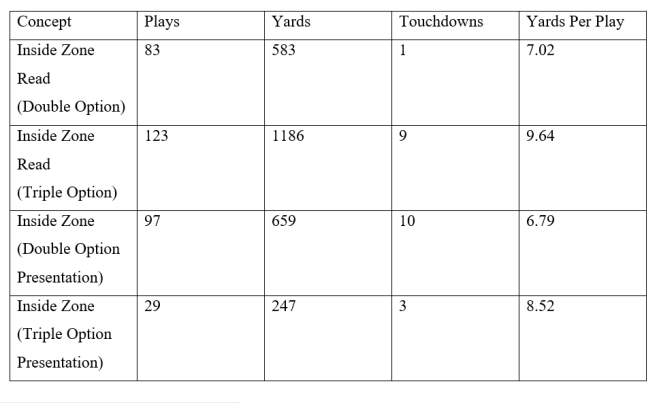
As I mentioned in the introductory paragraph, the inside zone read was the base play that really made this offense go. They would always run inside zone as either an option play, or as a called-give to the running back designed to look like an option play. With their inside zone read, the end-man on the line of scrimmage (EMLOS) would be the dive-key. When running their auto-give inside zone plays, the fullback would block the EMLOS. One of the great features of this offense was the amount of ways they could run the inside zone and inside zone read.
Here are the line rules that New Mexico utilized under Bob Debesse (former offensive coordinator under Willie Fritz) for inside zone.

For more on the inside zone blocking scheme, see here: http://lifeafterfootballblog.com/chip-kelly-clinic-notes/
Zone-Read Double Options
Georgia Southern had a good amount of success (7.02 yards per play) running double option zone read plays with the fullback in the game. They could run these plays in a few different ways, but they always utilized a fullback as a lead blocker in the backside alley for the QB if he kept the ball. The differentiating factor between their different double option zone read variations was how many fullbacks were in the game, and how they got to their block. By bringing the fullback into the alley, this would help slot receivers as they would always have a good blocking angle. The receivers would always be responsible for defenders the furthest away from the ball. For example, if you were to count defenders starting at the sideline in, outside receivers would be responsible for #1 (the corners), the slot receiver would be responsible for #2, and if the offense were to be in a trips set, the #3 receiver would be responsible for #3. In the diagram below, rather than having the slot receiver attempt to block the outside linebacker at a difficult angle, he is able to climb vertically straight to the safety because the offense is bringing the fullback into the alley to block the outside linebacker.
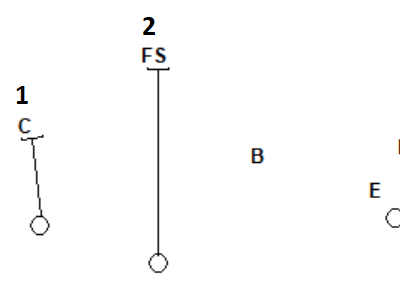
If the defense were to align with the outside linebacker expanded to the slot with the safety playing in the alley, then the outside linebacker would become the #2 defender meaning the slot would become responsible for him leaving the safety to be the alley defender blocked by the fullback.

IZ Arc
The first way that Georgia Southern could run their double option zone read play is with an “arc” block from the fullback (could also be ran from a backside tight end). The fullback will align away from the direction of the run and arc to the alley to block the most dangerous defender who appears. In the diagram below, he is responsible for the strong safety.

Below is an example of Georgia Southern running this play. Appalachian State is in a 3-man front making their outside linebacker the EMLOS. The EMLOS stays wide so the QB gives the ball to the back, effectively “blocking” that defender by always making him wrong with his read. This play most commonly (but not always) resulted in a give to the back as the EMLOS could be widened by the fullbacks arc to the perimeter.

One way that the defense could effectively play the zone-read was through the “scrape (or gap) exchange” (shown above). The defense will pinch the end down forcing the QB to pull the ball while scraping the backside linebacker around to play the QB. Some people have said that the arc block by the fullback is a possible answer for scrape exchange as he could arc and seal the scraping linebacker. However, if the fullback were to block the scraping linebacker, then the alley defender who he was originally responsible for becomes unblocked and the defense still gains an unaccounted for defender on the perimeter. In the following video, you can see that if the fullback were to turn inside to block the scraping linebacker, the strong safety would have been unblocked, and the offense would have been in a bad situation either way.
IZ Bluff
Another way that Georgia Southern could run their double option zone read play was to utilize a “bluff” block from the fullback. This time the fullback would start on the playside and come across the formation to his block in the backside alley. This play was more likely to result in a keep read for the QB because a lot of defensive ends are taught to pinch and “wrong-arm” the fullback if it appears that he is coming across on a “slice” block to kick him out. The perimeter blocking is still the same as IZ Arc and the fullback is still responsible for the same defender. The fullback coming across the formation post-snap also gives the play more of a split-flow look causing some more misdirection and increasing the odds of a defender making a mistake in his run fit/option responsibility.

Below is an example of a give read on IZ Bluff. The EMLOS stays wide causing the QB to give the ball, the backside linebacker is influenced out of his gap by the zone read threat allowing room for the back to clear the second level. The frontside safety is unable to make the play on the back allowing for a good gain for the offense.
Here is an example of the QB getting a keep read on this play. I mentioned earlier how the defense can use the scrape exchange to combat these zone read plays. The defense attempts to use that very tactic on the following play, however the offense is able to account for the scraping linebacker because of their use of an unbalanced formation. On most option plays, there is 1 defender (the ball carrier’s counterpart) who will be unaccounted for. This defender is usually one of the safeties. When the offense lines up in an unbalanced formation and runs to the “nub”, the frontside corner, who is usually the worst tackler on the field, now becomes unaccounted for. When the defense executes their scrape exchange, they are still gaining a second unaccounted for defender because the offense is still using two players (BST and fullback) to account for one defender, however the offense, by strategic use of this unbalanced formation has forced the frontside corner and free safety to be the 2 unaccounted for defenders. This way, the offense still has a numbers advantage (5 on 4) in the backside alley if the QB keeps the ball.
This time, New Mexico St is able to successfully execute a scrape exchange giving themselves 2 defenders to match 2 offensive players in the alley. With the lack of a backside 3-technique, the BST is free to climb straight to his block because there is no-one for him to double team. Sometimes, with an athletic tackle, he can account for the scraping linebacker by kicking him out, however the offense can usually not always count on that as seen on this play.
IZ Arc-Bluff
Georgia Southern could also run their double option zone read play with 2 fullbacks in the game. One fullback would execute an arc block while the other would execute his bluff block. The fullback arc blocking will be responsible for the alley defender as he would normally be. The second fullback on his bluff block will be responsible for the most dangerous defender to his inside after bypassing the EMLOS. It is more difficult for the defense to successfully execute a scrape exchange versus this play because the offense is bringing 3 players to the alley if the QB pulls the ball meaning the defense will also have to bring 3 players into the alley to match the offense.

Another way in which defenses can play the zone-read is by using the free safety (who is usually unaccounted for) as their QB player. Texas St commonly used this tactic in their 2014 matchup with Georgia Southern. Georgia Southern countered by using an unbalanced formation and running to the nub to make the frontside corner the unblocked defender allowing them to block the free safety on the backside. The EMLOS stays wide causing the QB to give the ball. The use of the unbalanced formation plus the post-snap movement created by the 2 fullbacks combined with the option threat increase the odds of the defense botching one of their responsibilities.
Georgia Southern uses the same unbalanced formation on the following play, however this time they run the ball to the 2 receiver side with the QB and both fullbacks coming back towards the nub. This can be difficult for the defense to play the QB because of the offense brining 3 players back to the nub side. However, with the offense running to the 2 receiver side, the slot receiver now has to come inside to block the outside linebacker, which as I stated earlier, is a tough block to execute. Because of this, the outside linebacker may be unblocked on the frontside of the play. You can see here that the backside linebacker scrapes, but the offense still maintains a 3 on 2 advantage on the backside of the play because the defense only scraped 1 player.

The defense can still execute a successful scrape exchange versus this play. To do so, they will have to bring both the outside linebacker and the MIKE linebacker to the backside alley to occupy both fullbacks which will free up the safety to play the QB. Even though the offense is unsuccessful with this particular play, it helps set up other plays in the series because of how much the defense has to move away from the box post-snap.
Zone-Read Triple Options
Although Georgia Southern was successful with their double option zone read plays, their triple option zone read plays were even more successful (9.64 yards per play) and were the unique feature that made them more difficult to prepare for compared to other offenses. It also helped set up other plays in their triple option series. They could run their zone-read triple option plays in one of 3 ways, without a fullback in the game, or with one who would execute either an arc or bluff block to the backside of the play depending upon his pre-snap alignment.
IZ Triple
This was Georgia Southern’s least run triple option play, nevertheless, it was still a good play for them when called. The perimeter blocking is the same on this play as it would be for IZ Arc or IZ Bluff. The alley defender who would have been blocked by the fullback on those plays will now become the pitch-key on this play.
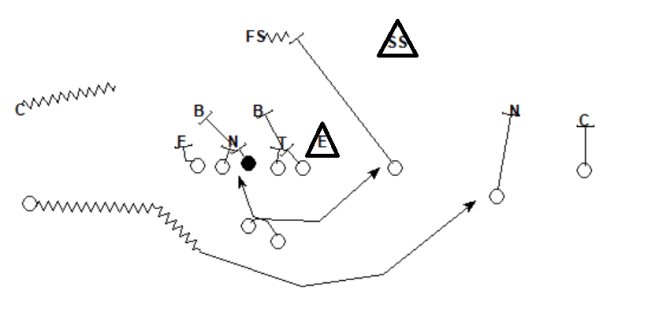
On the following play, Georgia Southern again utilizes an unbalanced formation and runs the ball to the nub (a tactic commonly used by this offense). This allows the offense to account for the free safety on the backside of the play. The #3 receiver is tagged to block the free safety leaving the strong safety in the alley to be the QB’s pitch-key. The EMLOS stays wide so the QB gives the ball to the back. With the backside end widened by the option threat, this creates nice cutback space for the back with both interior down lineman being pushed towards the playside.
IZ Arc Triple
Georgia Southern’s #1 triple option variation was to run it from a 3-back set with the fullback on an arc block. The fullback would arc around the end and then be responsible for the most dangerous defender to his inside. The force defender would become the pitch-key. Georgia Southern faced 2 primary looks from defenses when lining up in a 3-back set, the defense would most commonly either play a 4-3 with 2 high safeties or a 4-4 with 1-high safety. Not a lot of teams run triple option schemes from 3 back sets, so it adds difficulty for the defense when preparing to face this offense. One mistake from the defense with their run fits/option responsibilities could result in a big play for the offense. Georgia Southern could either run this play starting in a 3-back set or by aligning in a 2-back set and using either “orbit” or “orbit return” motion from the slot receiver.

Here is an example of Georgia Southern running this play versus a 4-3 look. Versus this look, the fullback will arc to block the backside outside linebacker and the backside safety will become the pitch-key. The end pinches and both the outside linebacker and safety play the pitch leaving no one on the QB leading to a big play for the offense.
Versus this 4-2 look from NC State (they were the only team who aligned this way), the fullback will arc to block the nickel player stacked behind the 2 linebackers. The backside safety will again become the pitch-key. Again the defense does not have anyone responsible for the QB allowing the QB to run almost 50 yards untouched.
Versus this look from South Alabama, the fullback will arc to block the nickel player running with the orbit motion from the slot. The backside safety is again the pitch-key. The EMLOS stays wide so the QB gives the ball to the back. The frontside safety is unable to fill correctly leading to a long touchdown from the back. The option threat removes any secondary support on the backside because of the nickel and backside safety both sprinting away from the box. This is one of the beauties of this offense. With RPO plays, the QB is able to hold overhang players and safeties outside of the box momentarily as he meshes with the back, however they are often able to rally back to the box after the ball is handed off. With the option, Georgia Southern is able to do a better job of threatening the perimeter so that these defenders have to be running away from the box taking away their ability to rally back to the box after the ball is handed off. This is one of the reasons why option teams usually have so many explosive runs.
Versus the 4-4 look from Idaho, the fullback will arc to seal the backside inside linebacker and the backside outside linebacker will become the pitch-key. For the defense to have success from this look, they will usually have the free safety be responsible for either the QB or the pitch. The free safety on this play does not get involved on the perimeter leading to another big play as the defense has no one responsible for the pitch. The QB will try to attack the pitch-keys outside and wait to pitch the ball until he has fully committed to the QB. A lot of people refer to the inside zone read with a backside bubble screen as the “new-school” triple option, however this play illustrates one of the advantages of still using a pitch-back. The pitch-key has to fully commit to the QB before the ball is pitched meaning that he has no chance to rally back to the perimeter. Even if the corner is able to force the ball inside of him, the offense has a true 2 on 1 advantage. Georgia Southern averaged nearly 14 yards per play when pitching the ball on this play.
The following play illustrates another one of the advantages of option football. Even though the defense seems to be in relatively good position to play the option, option football can cause defenders to hesitate and play slow as they are often unsure of themselves.
I mentioned earlier when discussing IZ Arc-Bluff that it is somewhat difficult to execute a successful scrape exchange when the offense is bringing 3 players to the alley/perimeter if the QB keeps the ball. The same idea applies here with this concept. In the following play, Georgia Tech uses the same strategy they used in the play I showed earlier. They pinch the end to force the ball to the perimeter and scrape both the outside and MIKE linebacker to take on the fullback and QB, which frees up the safety to play the pitch. I will discuss later in the article how the offense can take advantage of this defensive tactic.
This play is a good example of how the defense can play the triple option successfully from a single-high structure. Even though the offense uses an unbalanced formation which would allow them to account for the free safety on the backside, the line is “pushed” towards the playside corner meaning that the C/BSG combo on the backside 1-technique is now responsible for the corner and the BST is now responsible to climb for the playside linebacker. The fullback will arc to seal the backside inside linebacker and the backside outside linebacker becomes the pitch-key. The defense puts themselves in a good position by forcing the QB to keep it while having the outside linebacker play the QB and the free safety roll down to play the pitch. This play also shows what the QB should do in the event that the defense has an extra player outside the pitch-key. Rather than pitching the ball, he will fake the pitch attempting to influence the pitch-key and keep the ball cutting inside of him.
IZ Bluff Triple
Georgia Southern also had good success running their 3-back zone read triple option with a bluff block from the fullback. This gave the play even more of a split-flow dimension and helped set up one of the best plays in this offense (which I will discuss later in the article). The fullback is still responsible for blocking the most-dangerous defender to his inside after he bypasses the end and the QB will still option off the force defender if he keeps the ball.
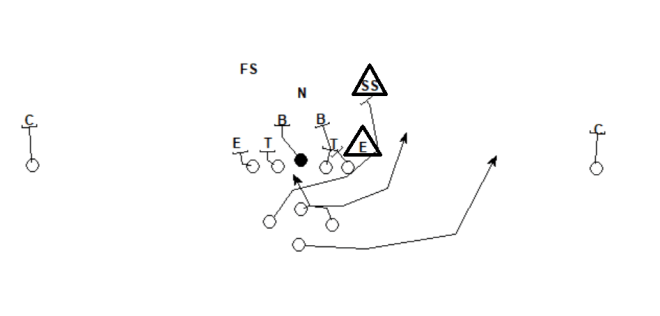
Versus this 4-2 look again from NC State, the bluff block will be responsible for the stacked nickel player and the backside safety becomes the pitch-key. Although this does not look like a good look to run the ball against with 9 defenders near the box, the EMLOS stays wide and is effectively blocked by the QB, and 4 defenders (backside linebacker, both safeties, and nickel player) are manipulated by the option threat and are no longer able to make a play on the back. This leaves 4 defenders with no secondary support for 5 lineman and 1 ball-carrier resulting in a 60 yard touchdown untouched on the inside zone.
Versus this 3-4 look from Georgia State, the backside outside linebacker is the EMLOS and becomes the dive-key. The fullback will be responsible for the backside inside linebacker and the strong safety becomes the pitch-key. The OLB pinches and the strong safety stays wide, so the QB keeps the ball. The backside inside linebacker is also influenced by the threat of the pitch allowing for an easy block for the fullback. The free safety does not get himself immediately involved allowing the QB to get 10 yards downfield untouched before reaching him.
Versus this 4-4 look from Savannah State, the fullback will look to seal the backside inside linebacker and the backside outside linebacker will be the pitch-key as normal versus this look. The end pinches and the outside linebacker takes the QB so the ball is pitched. The free safety does not get himself involved and the defense does not have anyone responsible for the pitch creating a big play for the offense. Again, the QB waits until the pitch-key has fully committed to him to pitch the ball.
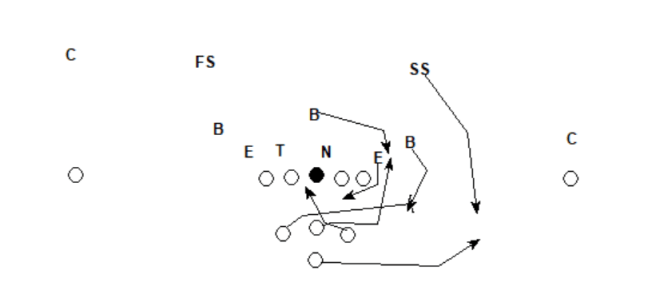
Georgia Tech this time uses a similar, yet slightly different strategy to stop this play as they did earlier versus IZ Arc-Bluff and IZ Arc Triple. They pinch the end forcing the ball to the perimeter, have the backside safety comedown to play the pitch, the outside linebacker starts wide and fits outside the fullback, which would force the QB to cut inside of him where the MIKE has scraped to. The back on his bluff block bypasses the outside linebacker and turns inside to block the MIKE which allows the outside linebacker to then become the QB player. The back should have probably kicked out the outside linebacker on his bluff block, however either way the offense would be in a bad situation.

I have mentioned throughout this article how the defense, if in a single-high alignment, has to get the free safety involved in order to have success on the perimeter versus 3-back triple option schemes. Here is an example of this. The defense spins to a single-high look in reaction to the motion from the slot receiver, they pinch the end, have the outside linebacker play the pitch and fill with the free safety on the QB. The FS knows his responsibility and plays fast allowing for success for the defense. But as most great offenses do, this offense had answers for when the defense was able to stop their base plays.
Inside Auto-Gives w/ Option Presentation
Georgia Southern’s best answer for teams who were playing different games designed to force the ball to the perimeter were to run inside zone plays that were automatic gives to the running back designed to look like option plays. They would do this by having the fullback block the EMLOS, and normally defenders would just take themselves completely out of the play by chasing the option fake. As I’ve shown in this article, most defensive strategies designed to stop the option include the end pinching because they know the QB will pull the ball. Well, when that player is blocked, the defense is exposed inside the box because of them scraping defenders to the perimeter where they expect the ball to be. Flexbone teams have been using called-gives designed to look like option plays for years. Below is a diagram of the flexbone Zone Dive play, a called FB dive play designed to look like inside veer triple option.
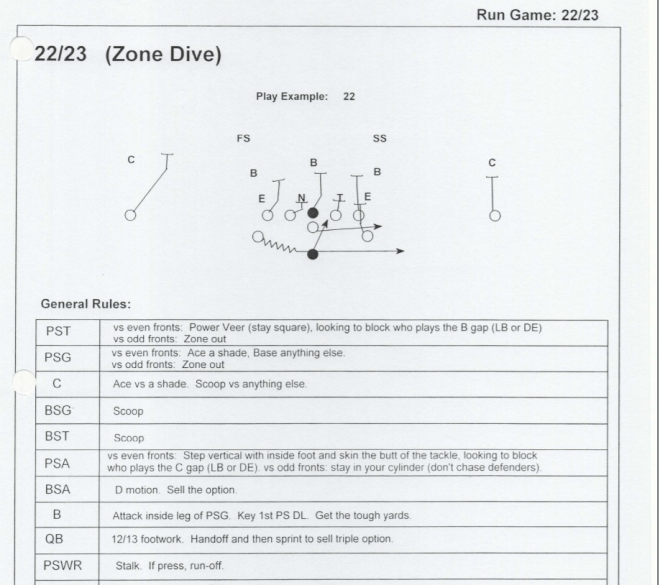
Here is an example of Army running this play against North Texas in their 2016 bowl game. You can see multiple North Texas defenders run right by the fullback in their pursuit of the perimeter option.
Inside Zone Auto-Gives w/ Double Option Presentation
Georgia Southern had 2 different methods for running inside zone designed to look like one of their double option plays. They had 1 designed to look like IZ Arc, while the other was designed to look like IZ Bluff.
IZ Cap
Their called-give play that they ran the most in 2014 was an inside zone play with the fullback starting on the backside of the formation as he would with IZ Arc. Instead of him arcing to the alley, he would kick out the EMLOS. Usually, defenders outside of the box would be held by the option fake. The option fake also frequently influenced the backside linebacker out of the box leaving the defense short a gap.
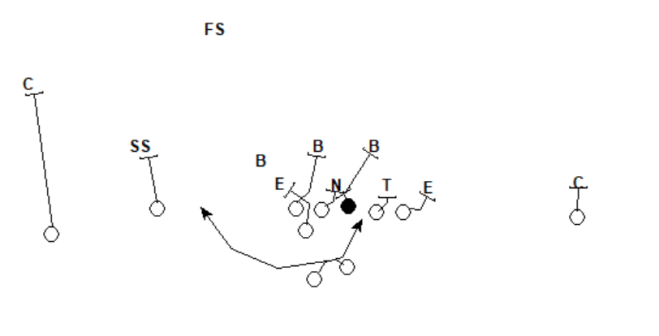
In the following clip, the backside outside linebacker is influenced and held by the QB’s option fake. The defense is left with no secondary run support and only 5 defenders in position to make a play on the back. With 5 blockers and 1 ball-carrier, the offense maintains the advantage allowing for another long untouched touchdown run (a common theme in this offense).
IZ Split
The other called-give Georgia Southern ran off of their double option zone read plays was IZ Split. The fullback this time will start on the playside before coming across the formation and kicking out the EMLOS. The split-flow inside zone is a pretty common play, however it can be much more effective when ran by a team who heavily utilizes the zone-read.

In the following clip, both the backside linebacker and backside safety remove themselves from the play in preparation to play the perimeter option. The frontside safety is able to do a good job filling preventing a bigger play for the offense, but you can see the space created inside the box by the option influence.
IZ Arc-Split
Although Georgia Southern didn’t actually run this play, New Mexico’s offense coordinated by Bob DeBesse, a former offensive coordinator for Willie Fritz at Sam Houston St, has had a good amount of success using it. This play is designed to work off of IZ Arc-Bluff. The fullback will take a wide arcing release while another back will come across on his split block to kick out the EMLOS. Usually, multiple defenders are influenced by the fullback’s arc block and removed from the play.

I mentioned briefly earlier how the scrape exchange is sometimes also referred to as “gap-exchange”. In the following clip, the defense attempts to pinch the end to play the backside B gap, while the linebacker scrapes to play the QB and backside C gap. The backside outside linebacker is held by the option fake, and the offense is able to kick-out the end leaving the backside B gap open as the backside linebacker scrapes himself out of the play. The running back is able to make the free safety miss leading to another long touchdown run.
Inside Zone Auto-Gives w/ Triple Option Presentation
Although Georgia Southern had success with their inside zone auto-gives designed to look like double option plays (6.79 yards per play), they had even more success when they were ran with triple option presentation (8.52 yards per play). This is likely because it requires more post-snap movement from the defense away from the box to successfully stop a 3-back triple option play on the perimeter.
IZ Cap Triple
Georgia Southern did not run this play much (only 4 times), but they could also run IZ Cap with triple option presentation.
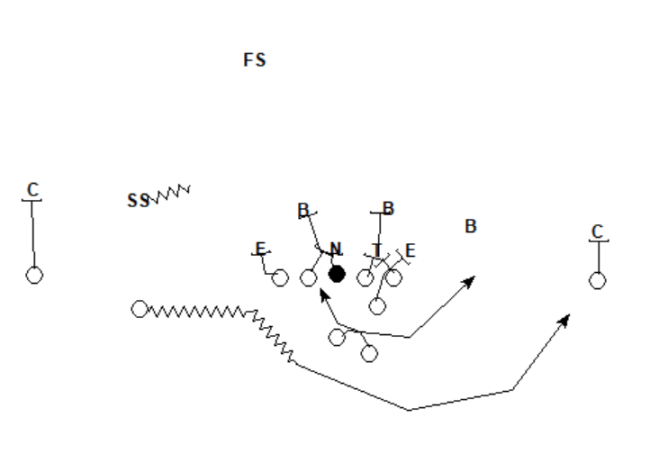
Although this isn’t the greatest look to run IZ Cap Triple against as the offense will not be able to block the strong safety on the playside when he bumps in with the motion, they are still able to hold the backside outside linebacker and influence the backside inside linebacker with the option fake. This allows the running back to still reach 6 yards downfield before being contacted by the unblocked defender.
IZ Split Triple
Arguably one of the best plays in this offense is IZ Split ran with triple option presentation. It takes a little bit more time before the fullback kicks out the EMLOS when he is coming across the formation which helps to sell the option more. Anyone who has watched New Mexico play in recent years has likely seen multiple big runs from them using this play. In their 2016 matchup with Wyoming, in which they ran for 432 yards in the first half alone, they had touchdown runs of 53, 39, and 59 yards on this particular play.
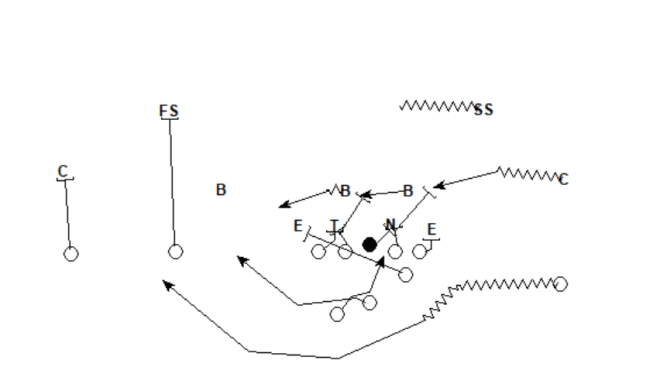
Georgia Southern again uses an unbalanced formation and runs the ball to the nub side. Normally the corner would be unblocked on the frontside of this play, however both inside linebackers are influenced by the option threat causing them both to slide towards the backside of the play. The lineman stay on their zone tracks, and because of the movement from these defenders, the PSG slides off to block the corner and the BST slides off his double team to block the playside linebacker. The option fake removes the backside inside linebacker from the play and holds the backside outside linebacker outside of the box. The frontside safety bumps towards the middle of the field with the motion leaving no secondary support on the frontside.
Power
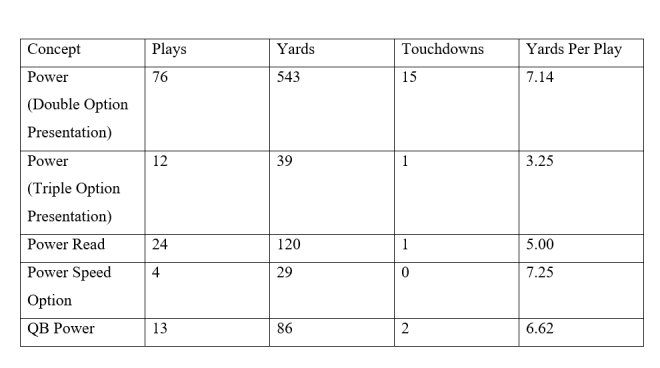
By running power, Georgia Southern gave themselves another way to run called-gives to the back with option presentation while also breaking tendencies with power read. With power read, they could run an option play where both options went away from the back’s pre-snap alignment as opposed to their inside zone read plays where the defense knew that the perimeter option threat would be towards the back’s alignment.
Here are the line rules that New Mexico used for power under Bob Debesse (Former Willie Fritz Assistant).
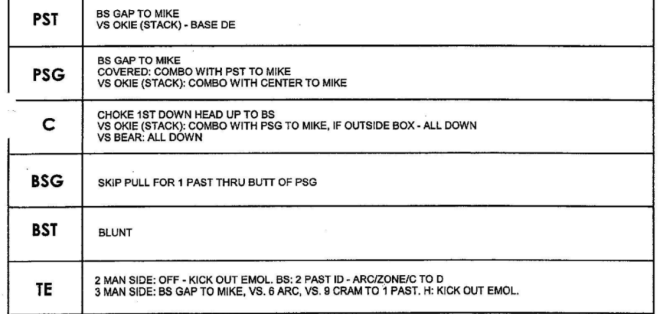
Power (Double Option Presentation)
Georgia Southern most frequently ran power with the presentation of a double option zone read play. The option fake negated the need for them to attach RPOs to this play as the QB would normally be able to hold overhang and secondary players by carrying out his option fake. He would also sometimes be able to influence box defenders out of their gap.
20 Personnel Power
Georgia Southern most frequently ran this play from 20 personnel where the fullback would start on the playside and be responsible for blocking the EMLOS. He would attempt to kick-out this defender, but could also log him if the defender was pinching inside.
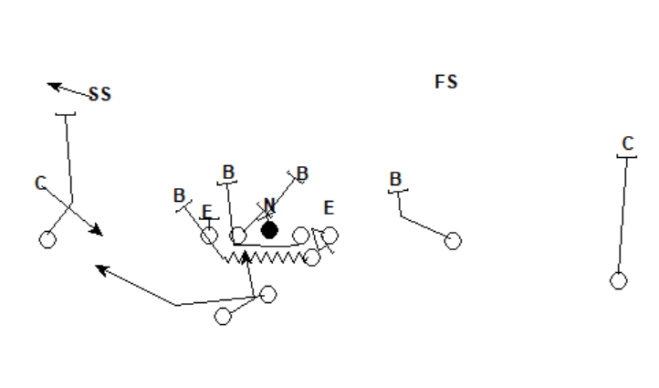
In the following play, Appalachian State brings a boundary corner blitz, so the outside receiver should climb to block the safety. The corner is held by the QB’s fake preventing him from making a play on the back. The outside linebacker pinches so the fullback logs him and the guard pulls all the way around the fullback. Both linebackers scrape as they see the zone-read like mesh which helps to set up the pulling guard to kick out the playside linebacker. With both linebackers scraping, the running back stays inside both the pulling guard and the PSG on his down block. With no secondary support, this again becomes a long untouched touchdown run.
21 Personnel Power
Georgia Southern could also run this play from 21 personnel with both a tight end and fullback on the frontside of the play. This was one of their best plays to run on the goal line and in short yardage situations. They especially liked to run this play versus 3-man fronts because the tight end could double team with the PST on the 4i, which would help create a nice gap to run in after the fullback kicked out the outside linebacker.
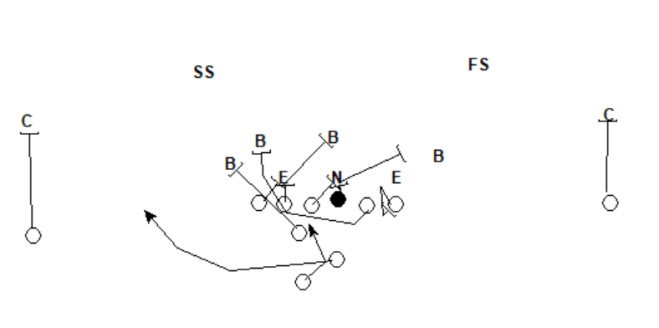
In the following play, the playside inside linebacker scrapes himself out of position as he sees the option presentation, so the pulling guard doesn’t even have to block anyone for the running back to clear the second level. The running back is able to make the frontside safety miss turning an already successful 3rd and 2 conversion into an explosive touchdown run.
Power (Triple Option Presentation)
Although Georgia Southern did not utilize this play a ton, they could also run power with triple option presentation.

With Texas State aligned in a 4-man front with the EMLOS outside of the tight end, the tight end, instead of down blocking, will block out on the end, and the fullback will insert inside of his block. You can see that the triple option presentation helps to influence 4 defenders (playside end and outside linebacker, both safeties) creating good space for the back inside on the power play.
Power Read
As I discussed earlier, power read was a great way for Georgia Southern to break tendencies when it came to the pre-snap alignment of their back. While I don’t know for sure, I suspect this was one of the reasons why they did not use much pistol. Georgia Southern would block it the same upfront, except the fullback would arc to block the playside linebacker leaving the EMLOS to be the QB’s read key. The backfield action of this play would force a lot of movement from second level defenders increasing the odds of the defense having a gap unaccounted for. Auburn O-Line coach, J.B. Grimes, once described power read as the play where “we don’t have to block anyone” in reference to the offensive line.
Power Read Arc
Georgia Southern would almost always run this play with an arc block from the fullback. This was because the offense could normally count on the playside linebacker naturally scraping to play the sweep because of the fast flowing nature of the play. When ran with 1 arc block, the fullback would always be responsible for blocking the playside linebacker. On the perimeter, the receivers will be responsible for the most dangerous defenders. For example, if the offense were running this play to a slot receiver and the defense were to align in a 2-high structure, the slot receiver would have to block the outside linebacker and the safety would be left unblocked.
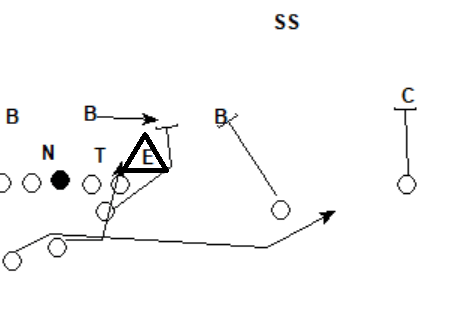

Savannah State’s 4-3 was a great look to run this play against because the offense could account for every defender on the perimeter. The EMLOS initially starts to pinch but eventually widens as he comes upfield so the QB keeps the ball and follows his pulling guard. You can see how the backfield action helped move second-level defenders and created a lot of space for the QB once he pulled the ball.
Power Read Dbl Arc
Georgia Southern could also run this play from a 3-back set giving them an extra lead blocker on the perimeter if the QB handed the ball off to the back. Because of the 3-back formation and the extra arc block, the offense is usually able to account for every perimeter defender because the defense will usually only have 1 defender aligned pre-snap in the alley.

Versus New Mexico State’s 4-4, the fullback will arc to block the outside linebacker and the playside back will arc to block the playside inside linebacker. The EMLOS pinches so the QB gives the ball on the sweep to the back. The offense is able to account for both the alley defender and the scraping linebacker because of the two arc blocks.
Orbit Power Read Arc
Another way Georgia Southern could break tendencies is to use orbit motion with power read. With the orbit motion traveling towards the back, it gives the pre-snap appearance that the offense is about to run an inside zone triple option play. This helps hold defenders and reduce second and third level flow towards the perimeter on the power read play.

You can see on this play how all of Idaho’s linebackers slide over with the orbit motion and are no longer fast flowing towards the power read because they are expecting the offense to run a triple option play. The free safety, similarly to how some teams play the zone read, is frequently responsible for giving perimeter support versus power read when teams are aligned in single-high safety structures. The free safety is hesitant because of the misdirection allowing the back to beat him to the edge.
Power Speed Option
Georgia Southern could also run a power read-like play with speed option mechanics. This play is very similar to the power toss read that has been popularized in recent years. Georgia Southern likely used speed option mechanics instead of toss mechanics because of how much option they already ran.

The frontside slot receiver will be responsible for the most dangerous defender as he would be if they were running power read. Versus a 2-High look, he will almost always be sealing the frontside linebacker leaving the safety unaccounted for. Because the safety is unaccounted for, this was a better play for them ran into the boundary because the ball can get up field quicker before the unblocked safety can fill and it also provides an easier block for the slot receiver compared to if they were to run this play to the field. This play will almost always result in a pitch, especially when using speed option mechanics, because the EMLOS has to get very wide quickly to be able to stop the pitch.
Counter

Georgia Southern had another called-give that they could run with option presentation in counter. The blocking scheme is essentially the same as power, except the BSG and fullback exchange responsibilities. Instead of the fullback blocking the EMLOS and the BSG pulling for the playside linebacker, the BSG would pull for the EMLOS and the fullback would lead on the playside linebacker.
For more on power/counter blocking schemes, see here: http://grantland.com/the-triangle/2015-nfl-college-football-power-running-counter-running/
Counter (Double Option Presentation)
The thinking behind this counter play is very similar to Georgia Southern’s power play. The QB will mesh with the back as he would on a zone-read play, and he will attempt to hold perimeter defenders with his option fake. The zone-read like mesh also helps set up the pullers for their blocks on the EMLOS and playside linebacker.

You can see on this play how the zone-read like mesh can help set up both pullers. The EMLOS and playside linebacker are thinking that it is a zone-read play, and are not expecting the pullers to come giving them easier blocks to execute.
Speed Option

Although Inside Zone was the play that really made this offense go, speed option was statistically their most efficient scheme averaging nearly 9 yards per play. Whereas most spread teams will option off the playside end on speed option, Georgia Southern would use the tight end to help the PST reach the end so that they could get the QB on the edge and option off a perimeter defender. The rest of the line would reach with the backside of the line cutting the nearest defender.
Here are the line rules that New Mexico used for speed option under Bob DeBesse (Former Willie Fritz Assistant).
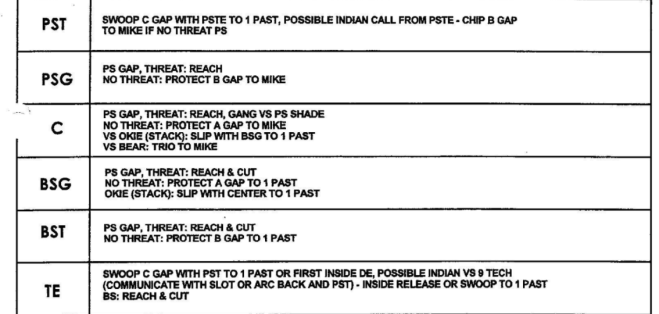
Speed Option
When running speed option, Georgia Southern would use the same perimeter blocking I described earlier in the article when discussing their double option zone read plays. They would option off the first defender aligned outside the tight end, this was usually the alley defender who the fullback would be blocking on their double option zone read plays.
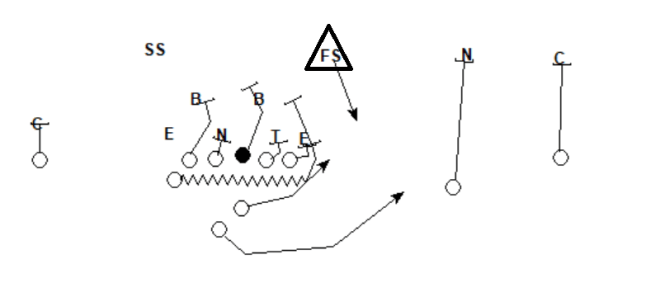
In the following play, the slot receiver will block the nickel defender lined up directly over him. The frontside safety who rolls down to the alley will be the QB’s pitch-key. Like he would on a triple option play, the QB will threaten that defender’s outside until either he commits to the QB or he runs past the QB. The moment the pitch-key runs past the QB, he knows he is keeping the ball and will look to turn upfield. The PST is able to reach the playside end, so the fullback then turns inside to seal the playside linebacker. This allows the QB to get the edge, and with the free safety taking the pitch, there is a lot of running room for the QB.
Speed Option Arc
Georgia Southern could also run this play from 21 personnel giving themselves an extra lead blocker if the QB kept the ball. The fullback would arc inside of the pitch-key and block the most dangerous defender.

In the following play, the outside linebacker will be the pitch-key. Because both options are going towards the perimeter, the line does not have to block the backside EMLOS. With the added arc block accounting for the free safety, the offense is able to account for every defender on the playside. The PST and tight end are able to seal the edge, the outside linebacker takes the pitch and the fullback is able to lead on the free safety leading to another untouched long touchdown run.
Georgia Southern would struggle on this play when they were unable to reach the playside end. The following clip is an example of this. The PST is unable to hold his block once the tight end leaves and the end is able to stretch the play out so that the offense is unable to gain a 2 on 1 on the pitch-key.
Load Option

Load Option
Another speed option variant that Georgia Southern ran was Load Option. With Load Option, they could gain an extra blocker on the perimeter because the fullback would not be responsible for helping to seal the edge. The PST would always down block, and the PSG would pull and cut the first defender who appeared. Versus a 4-man front, the thinking behind the play is that the playside end will squeeze as the tackle down blocks allowing the pulling guard to cut him and for the offense to get the edge easily. Versus a 3-man front, the PST would down block on the 4i, causing the guard to lead up to the second level. They would again option off the first defender outside the tight end/fullback. The fullback would block the most dangerous defender inside the pitch-key as he would on Speed Option Arc. The backside of the line would reach and cut just like they would on Georgia Southern’s speed option play.
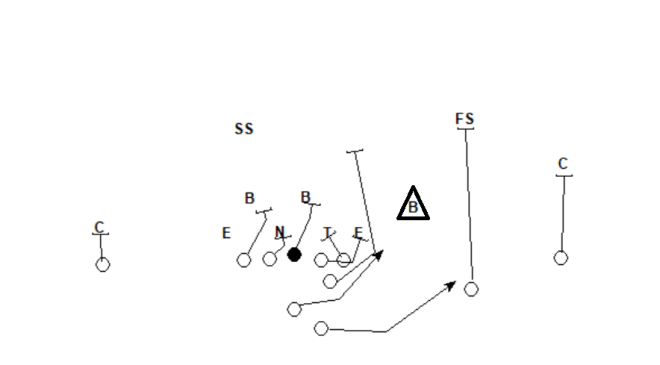
Here is an example of this play versus a 4-man front. The end squeezes so far on the tackle’s down block that the offense doesn’t even have to block him. Because of this, the guard just turns up and looks for work on the second level. The outside linebacker takes the pitch, so the QB turns up following his fullback.
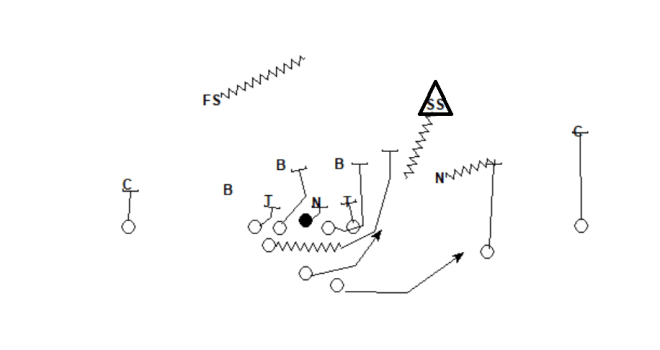
Here is an example of this play versus a 3-man front. The strong safety becomes the pitch-key after he rolls down to the alley in response to the motion. The tackle down blocks on the 4i, allowing the guard to lead up to the second level. The safety commits to the QB so he pitches the ball to the back giving the offense a 3 on 2 advantage on the perimeter.
As was the case with speed option, Georgia Southern struggled on this play when they were unable to execute their block on the playside end. You can see on the following play that the end recognizes the play and starts to widen preventing the pulling guard from being able to cut him. Because of this, the QB is never able to get to the edge and cannot reach the pitch-key.
QB Draw

QB Draw was the one run scheme that Georgia Southern would frequently run as a RPO scheme. The blocking scheme is very similar to inside zone, but the techniques utilized by the offensive line are different. As far as the scheme goes, the backside tackle will always “lock” on the backside end leaving the backside linebacker to be either read or blocked by the running back depending upon the play. The rest of the line still follows their zone rules (in relation to who to block, the techniques are different).
QB Draw – Swing Screen
The first of Georgia Southern’s 2 QB Draw schemes was to pair QB Draw with a backside swing screen. The receivers would block the most dangerous defenders and the QB would read the backside linebacker. If he left the box with the back, the QB would keep the ball attacking the box space that was vacated. If the linebacker took a pass drop and stayed near the box, the QB would throw the ball to the running back on his swing route.
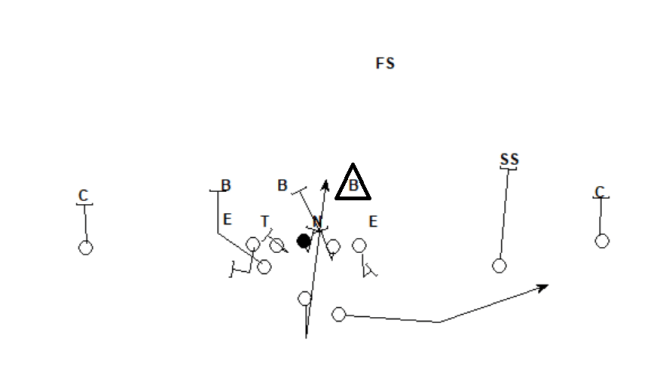
In the following play, the backside linebacker leaves the box as the running back swings out, creating a lot of open space in the middle for the QB once he keeps it on the draw play.
This time, the backside linebacker stays near the box as he takes his pass drop, so the QB throws the ball to the back on the swing screen. With the backside linebacker staying near the box, the offense is able to gain a 3 on 2 advantage on the perimeter. The linebacker will be able to rally back outside after the back gets a few yards upfield, but this is still a good way to get your back in space while also giving yourself the opportunity at a great QB run look.
QB Lead Stick Draw
Georgia Southern could also run lead QB draw paired with the Y-Stick passing concept. The blocking scheme is the same for the offensive line, the only difference is the running back will block the backside linebacker who would have been the QB’s read-key when paired with a backside swing screen. For the Y-Stick passing concept, the #1 receiver will run a vertical, #2 will run a 5 yard out, and #3 will run a 5 yard “stick” route. The offense is attempting to stretch the outside linebacker with the out route by #2 to open up space for the stick route by #3.
For more on Y Stick (and other passing concepts), see here: http://smartfootball.com/passing/snag-stick-and-the-importance-of-triangles-yes-triangles-in-the-passing-game#sthash.OdBEGM09.dpbs
If the stick route is covered, then the offense will likely have a numbers advantage in the box and the QB will keep the ball on the lead draw play.

In the following play, the MIKE linebacker starts to expand to the stick route so the QB keeps the ball. This gives the offense 6 blockers for 6 defenders in the box with the running back ready to block the MIKE as he returns to the box.
This time, no one from the box expands to the stick and with the defender in man coverage over #3 playing off, the QB throws the ball to the open receiver on the stick route. This is a good ball control play as the offense is able normally gain at least 5 if the stick is open, but can gain more if the receiver is able to make a defender miss after the catch as he does on this play.
If anyone has any questions or comments on the article, you can contact me by email at TaylorKolste@gmail.com or on twitter at @TaylorKolste.

Great Job. Lots of useful info delivered in a concise manner
LikeLike
This is fantastic work. Thanks from a GS fan.
LikeLike
You’re welcome, I would guess that GA Southern’s run game this year will look similar to this with Bob DeBesse as their new OC.
LikeLike
Taylor – how much of this is carrying over successfully at Tulane? Thanks!
LikeLike
The offense is similar yet slightly different at Tulane. Seems like Fritz has diversified it a little more and added in some more RPO stuff. They still run all of the zone read concepts from this article, and that’s really the base of that offense. Would have to watch more of them to see how similar the rest of the offense is, but they’re inside zone read double and triple-options and then called gives off of those still make up the base of the offense.
LikeLike
Great site. Just discovered it and came across the Fritz article first. Tremendous breakdown of the scheme. Would love to see a follow up and see how Coach Fritz incorporates RPOs into this offense.
Anyway keep up the excellent work. You guys and Ian Boyd are my favorite X and O reads.
LikeLike